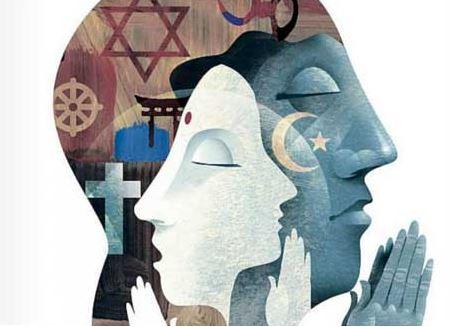Syncretism

🔄 What Is Syncretism?
Syncretism is the blending or merging of different beliefs, traditions, or systems — especially in religion, philosophy, or culture — into something new or hybrid.
Think: fusion of ideas across boundaries.
💬 Simple Definition:
Syncretism = the mixing of multiple worldviews or traditions into a unified or coexisting system.
🕊️ Religious Syncretism Examples:
-
Christianity + Indigenous Traditions
-
In Latin America, Catholicism often blends with local Indigenous or African beliefs.
-
Example: The Virgin of Guadalupe (Mexico) can be seen as a fusion of Mary and earlier Aztec goddess imagery.
-
-
Hellenistic Egypt
-
The god Serapis was created to unite Greek and Egyptian religious ideas under one deity.
-
-
Vodou / Voodoo
-
In Haiti, African spiritual practices blended with Catholic saints and rites.
-
-
The Bahá'í Faith
-
Embraces unity across religions — believes all major world religions reflect the same spiritual truth.
-
🧠 Philosophical Syncretism:
This shows up when thinkers try to combine different schools of thought:
-
Neoplatonism mixed Plato, Aristotle, mysticism, and more.
-
Renaissance thinkers like Pico della Mirandola tried to reconcile Christianity with Kabbalah, Hermeticism, and Greek philosophy.
-
Jungian psychology borrows from alchemy, mythology, Eastern and Western religions — a very syncretic approach to the psyche.
🎨 Cultural Syncretism:
When music, language, fashion, or rituals blend:
-
Jazz = African rhythms + European instruments
-
Creole languages = born from contact between different linguistic communities
-
Cuisine = fusion food (e.g. Korean tacos, or Japanese curry)
⚡ Why It Happens
Syncretism tends to emerge when:
-
Different cultures come into contact (e.g. colonization, trade, migration)
-
People need to reconcile contradictions or create unity
-
Thinkers or seekers want to synthesize truth across boundaries
🌀 Swedenborg and Syncretism?
While Swedenborg wasn't intentionally syncretic, his spiritual ideas overlap with mystical traditions from Christianity, Kabbalah, Neoplatonism, even Eastern concepts like karma or reincarnation. He created his own unified symbolic worldview, which is often attractive to people who resonate with esoteric syncretism.
🧘♀️ What Is Spiritual Syncretism?
Spiritual syncretism is when people blend beliefs, practices, and ideas from multiple religious or mystical systems into a personal or communal path. It’s about finding unity or resonance across different traditions.
Think: a spiritual playlist made from multiple albums — but with meaning, ritual, and soul.
✨ Why People Are Drawn to It:
-
They see truth in many traditions, not just one.
-
They’ve had spiritual experiences that don’t fit neatly into dogma.
-
They’re seeking something more holistic or universal.
-
They’re reclaiming or integrating ancestral or indigenous knowledge.
-
They’re on a personal spiritual path (vs. organized religion).
🕯️ Examples of Spiritual Syncretism
1. Gnostic Christianity
-
Early Christians who mixed Christian beliefs with Greek philosophy, Egyptian mysticism, and Zoroastrian dualism.
-
Focused on inner knowledge (gnosis) over blind faith.
2. Theosophy
-
19th–20th century movement blending Eastern philosophy (Hinduism, Buddhism) with Western esotericism (Kabbalah, Hermeticism, Christian mysticism).
-
Big influence on New Age thought.
3. New Age Spirituality
-
A modern syncretic movement pulling from:
-
Astrology
-
Crystals
-
Chakras (Hinduism/Buddhism)
-
Angels (Christianity)
-
Tarot / Kabbalah (Western mysticism)
-
Indigenous rituals (like smudging or sweat lodges)
-
4. Sufism
-
Mystical Islam, but often seen as universal and deeply influenced by Neoplatonism and Persian poetry.
-
Sufi poetry (like Rumi’s) blends spiritual truths from many wells.
5. Afro-Caribbean Religions
-
Santería, Vodou, and Candomblé mix Catholic saints with African deities (Orishas, Loa), plus local folk magic.
6. Buddhism in the West
-
Often blends meditation practices with psychology, Christianity, or even quantum metaphysics.
🌐 Common Themes in Spiritual Syncretism:
-
Unity of all paths (e.g., “All rivers lead to the ocean”)
-
Personal revelation over dogma
-
Emphasis on direct experience (meditation, ritual, altered states)
-
Use of symbolism, archetypes, sacred geometry, nature
-
Belief in hidden or esoteric truths underlying mainstream religions
📿 How People Practice It Today:
-
Doing yoga while also going to church
-
Praying with rosary beads and using sage or crystals
-
Reading the Bible and the Bhagavad Gita
-
Working with Tarot, astrology, and angel numbers
-
Celebrating both Pagan sabbats and Christian holidays
🌀 Potential Power and Tension
Power:
-
More inclusive, adaptive, and personally meaningful.
-
Encourages curiosity, compassion, and inner work.
Tension:
-
Can be seen as “picking and choosing” or misappropriating.
-
May clash with orthodox religious teachings.
-
Raises questions: “Is everything compatible?” or “Does depth get lost in blending?”

